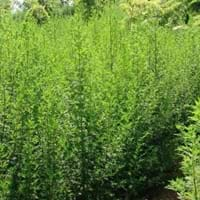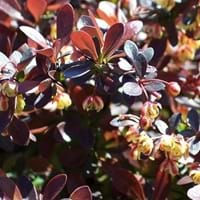Life Span
Annual
Perennial
Origin
Hybrid origin
Japan
Types
Not available
not available
Habitat
Subtropical forests, Tropical Forests
All sorts of environments
USDA Hardiness Zone
Not Available
4-8
Sunset Zone
Not Available
A3, 2b, 3a, 3b, 4, 5, 6, 7, 8, 9, 10, 11, 12, 13, 14, 15, 16, 17, 18, 19, 20, 21, 22, 23, 24
Habit
Upright/Erect
Oval or Rounded
Flower Color
Not Available
Yellow, Yellow green
Flower Color Modifier
Not Available
Not Available
Fruit Color
Not Available
Red
Leaf Color in Spring
Not Available
Crimson, Dark Red
Leaf Color in Summer
Not Available
Dark Red, Bronze
Leaf Color in Fall
Not Available
Red, Dark Red, Bronze
Leaf Color in Winter
Not Available
Not Available
Leaf Shape
bipinnate
Acuminate
Plant Season
Spring, Summer, Fall
Spring, Summer, Fall, Winter
Sunlight
Full Sun, Partial Sun
Full Sun, Partial Sun
Type of Soil
Loam, Sand
Clay, Loam, Sand
The pH of Soil
Acidic, Neutral
Acidic, Neutral, Alkaline
Soil Drainage
Well drained
Average
Bloom Time
Not Available
Spring, Late Spring
Tolerances
Drought, Salt
Pollution, Drought, Salt, Soil Compaction
Where to Plant?
Ground, Pot
Ground, Pot
How to Plant?
Seedlings
Cuttings
Plant Maintenance
Medium
Medium
Watering Requirements
Average Water Needs
Average Water Needs
In Summer
Lots of watering
Lots of watering
In Spring
Moderate
Moderate
In Winter
Average Water
Average Water
Soil pH
Acidic, Neutral
Acidic, Neutral, Alkaline
Soil Type
Loam, Sand
Clay, Loam, Sand
Soil Drainage Capacity
Well drained
Average
Sun Exposure
Full Sun, Partial Sun
Full Sun, Partial Sun
Pruning
Remove damaged leaves, Remove dead branches, Remove dead leaves
Prune if you want to improve plant shape, Remove damaged leaves, Remove dead branches, Remove dead leaves
Fertilizers
All-Purpose Liquid Fertilizer, Apply N-P-K
All-Purpose Liquid Fertilizer
Pests and Diseases
Aphids, Gray leaf blight, Root rot
Free of serious pests and diseases
Plant Tolerance
Drought, Salt
Drought, Pollution
Flowers
Insignificant
Insignificant
Flower Petal Number
Not Available
Single
Fragrant Bark/Stem
Yes
No
Foliage Texture
Not Available
Medium
Foliage Sheen
Not Available
Glossy
Attracts
Insects, Not Available
Birds
Aesthetic Uses
Not Used For Aesthetic Purpose
along a porch, deck or patio, Borders, Cottage Garden, Informal Hedge, Ornamental use
Beauty Benefits
Skin inflammation
Not Available
Environmental Uses
Air purification
Air purification
Medicinal Uses
Antioxidants, Fever, Inflammation, Malaria
No Medicinal Use
Part of Plant Used
Leaves
Not Available
Other Uses
Medicinal oil, Oil is used for aromatherapy
Showy Purposes
Used As Indoor Plant
No
No
Used As Outdoor Plant
Yes
Yes
Garden Design
Foundation, Mixed Border, Rock Garden, Wall
Container, Edging, Foundation, Hedges, Mixed Border, Rock Garden, Wall
Botanical Name
Artemisia annua
BERBERIS thunbergii f. atropurpurea 'Crimson Pygmy'
Common Name
sweet wormwood, sweet annie, sweet sagewort, annual mugwort
Japanese Burberry
In Hindi
Artemisia
crimson pygmy
In German
Artemisia
crimson pygmy
In French
Artemisia
crimson pygmy
In Spanish
Artemisia
crimson pygmy
In Greek
Αρτεμίσια
crimson pygmy
In Portuguese
Artemisia
crimson pygmy
In Polish
Artemisia
crimson pygmy
In Latin
Artemisia
crimson pygmy
Phylum
Magnoliophyta
Magnoliophyta
Class
Magnoliopsida
Magnoliopsida
Order
Asterales
Ranunculales
Family
Asteraceae
Berberidaceae
Clade
Angiosperms, Asterids, Eudicots
Angiosperms, Eudicots
Tribe
Anthemideae
Not Available
Subfamily
Asteroideae
Not Available
Number of Species
Not Available
Season and Care of Artemisia and Crimson Pygmy
Season and care of Artemisia and Crimson Pygmy is important to know. While considering everything about Artemisia and Crimson Pygmy Care, growing season is an essential factor. Artemisia season is Spring, Summer and Fall and Crimson Pygmy season is Spring, Summer and Fall. The type of soil for Artemisia is Loam, Sand and for Crimson Pygmy is Clay, Loam, Sand while the PH of soil for Artemisia is Acidic, Neutral and for Crimson Pygmy is Acidic, Neutral, Alkaline.
Artemisia and Crimson Pygmy Physical Information
Artemisia and Crimson Pygmy physical information is very important for comparison. Artemisia height is 150.00 cm and width 150.00 cm whereas Crimson Pygmy height is 45.70 cm and width 61.00 cm. The color specification of Artemisia and Crimson Pygmy are as follows:
Artemisia flower color: Not Available
Artemisia leaf color: Not Available
Crimson Pygmy flower color: Yellow and Yellow green
- Crimson Pygmy leaf color: Crimson and Dark Red
Care of Artemisia and Crimson Pygmy
Care of Artemisia and Crimson Pygmy include pruning, fertilizers, watering etc. Artemisia pruning is done Remove damaged leaves, Remove dead branches and Remove dead leaves and Crimson Pygmy pruning is done Prune if you want to improve plant shape, Remove damaged leaves, Remove dead branches and Remove dead leaves. In summer Artemisia needs Lots of watering and in winter, it needs Average Water. Whereas, in summer Crimson Pygmy needs Lots of watering and in winter, it needs Average Water.





